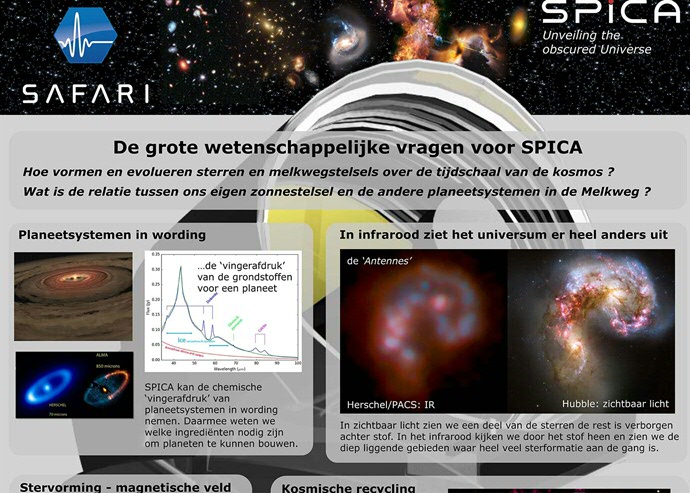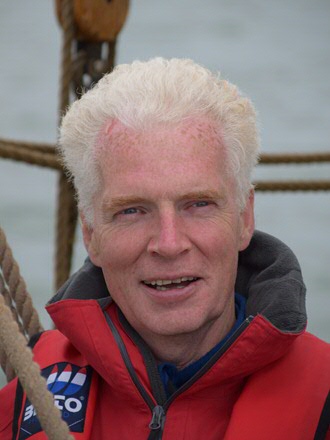SRON in finals with successor to Herschel satellite

Dutch singer Waylon made it to the finals of the Eurovision Song Contest in the beginning of May. Around the same time, Dutch astronomers made it to another European final – one that got considerably less press coverage – when the European Space Agency (ESA) announced that the SPace Infrared telescope for Cosmology and Astrophysics (SPICA) mission was one of three contenders for half a billion euros in funding. The hub for this proposal is in Groningen, with researcher Peter Roelfsema.
Text: René Fransen
About two years ago, Peter Roelfsema uploaded a huge proposal to the ESA computer server. ‘The SPICA satellite was very long in the making: the original idea dates from the 1990s. The total cost of the mission will be about one billion euros, and half of this budget depends on the ESA proposal’, says Roelfsema in his office in the Kapteyn Building on Zernike Campus. Roelfsema is PI for the project and one of his responsibilities was to prepare the proposal. ‘I did feel a bit apprehensive when I uploaded it.’
Star formation
The proposal is for a joint European-Japanese infrared satellite, SPICA, that should be launched in about ten years’ time. ‘The satellite has two main objectives’, explains Roelfsema. ‘The first is to study the development of star formation over the history of the Universe.’ Stars started to form relatively soon after the Big Bang, but it was a slow process at first. ‘Star formation took off when the Universe was about one billion years old. It then accelerated over the next three billion years but then began to slow down again.’ Astronomers want to know why this was. ‘What explains this “learning curve” in star formation? And what caused it to slow down again?’ One of the main SPICA instruments will be a spectrometer called SAFARI. SRON Netherlands Institute for Space Research is playing the lead role in developing this instrument. ‘And we have ample experience of coordinating large projects. That’s why we were given this lead role in the project, and why it was my responsibility as PI to submit it.’ Roelfsema works at SRON in Groningen but is also affiliated with the Kapteyn Institute for Astronomy at the University of Groningen. He became PI for SPICA some nine years ago.

Chemical fingerprint of galaxies
SPICA is a huge telescope, built to catch infrared light. SAFARI will be used to analyze this light. ‘We will take the chemical fingerprint of galaxies from up to ten billion years ago. SAFARI can tell us about their composition and temperature and about the movement of material and its density.’ By catching light from galaxies at very large distances, astronomers can look into the past: light travels at a constant speed, so light from a galaxy a billion light years from Earth shows that galaxy as it was a billion years ago. Roelfsema: ‘The extreme sensitivity of the telescope allows us to routinely study galaxies that existed as far back as when the Universe was about three billion years old. And there are ways to go back even further.’ This information about the composition of galaxies throughout the history of the Universe will give astronomers clues about factors that govern star formation. This work must be done with an infrared telescope, as star formation takes place in dust clouds which block visible and ultraviolet light. ‘That is the type of light the Hubble Space Telescope and its successor the James Webb Space Telescope (JWST) can see. They can only study the outside of galaxies, whereas SPICA will be able to penetrate deep into the heart of these large structures.’
Planetary systems
The second objective of SPICA is to study the formation of planetary systems in our own Milky Way. ‘This happens in protoplanetary discs, again deep inside in dust clouds. Our main objective is to study what is known as the snow line, the point at which water turns into ice.’ The distance of the snow line from the central star tells astronomers about the process and thermodynamics of planet formation. ‘This has been studied in previous infrared missions like Herschel. But SPICA will be about a hundred times more sensitive, so we will be able to measure many more of these objects. That will give us a large sample of developing planetary systems, which will give us a much better idea of how they form.’ Apart from these two main objectives of SPICA, it will also be used to study the debris left after a planetary system forms. ‘The rubbish that is left gathers in an outer belt. In our solar system we see that as the Oort Cloud. Studying these leftovers will also help us understand how planets are formed and how exo-planets relate to our own solar system.’
Important Dutch contributions
The SPICA telescope will build on observations by IRAS, ISO and Herschel, an impressive series of infrared telescopes to which Dutch science made important contributions. For example, SRON led the construction of the HIFI instrument for Herschel and has a similar role coordinating a major part of the development of the detectors in another mission, the Athena X-ray space telescope. ‘We have unparalleled experience of this type of project’, says Roelfsema. That is why with SPICA a Dutch research institute has been asked to lead a satellite mission for the first time ever. It is quite a challenge, Roelfsema explains. Many institutes from Europe, Japan, the US and Canada are involved in the project. ‘The original plan, over twenty years ago, was for JAXA, the Japanese space agency, to build the telescope. But due to funding problems in Japan the project faltered twice. So JAXA’s role is now smaller.’

Extremely sensitive detectors
SRON will supply the extremely sensitive detectors which will detect the infrared light. ‘These will operate at an extremely low temperature of 50 milliKelvin. They will be extremely sensitive, so we will need to cool the entire telescope to below 8 Kelvin or minus 265 degrees Celsius. Otherwise, infrared radiation from the telescope will totally overwhelm the detectors, swamping the signal from the sky.’ The detectors will be combined with a spectroscope in a box measuring about 1 x 1 x 0.5 metres. ‘The entire box will be cooled to 4 Kelvin, and the part with the detectors will be further cooled to their operating temperature. The cooling system is one of the biggest challenges in this mission.’ Similar cooling systems have been used in previous space missions, but not at the scale required for SPICA. And the detectors have been designed and built, but again not in the numbers required. ‘We can make single detectors, but we need 3,000 of them, on chips with 50 detectors each.’ So a lot of work will have to be done before SPICA can fly. If she flies, that is, because the project is one of three finalists – and only one will receive funding. ‘Without ESA funding, we won’t be able proceed with the mission. That will mean no follow up to Herschel and that an entire generation of astronomers may have to do without another infrared space mission.’ SPICA has three years to prove itself before ESA decides. ‘Being selected has improved the status of this project and will make it easier to get grants’, says Roelfsema. So will they win? Or will they fail like that other finalist, Waylon? Roelfsema is confident; his project is solid. ‘But as I have told my team, we must do our very best to beat the competition. The rest is up to the jury.’ We’ll have to wait three years to find out what they decide.
More information
| Last modified: | 12 March 2020 9.23 p.m. |
More news
-
03 April 2025
IMChip and MimeCure in top 10 of the national Academic Startup Competition
Prof. Tamalika Banerjee’s startup IMChip and Prof. Erik Frijlink and Dr. Luke van der Koog’s startup MimeCure have made it into the top 10 of the national Academic Startup Competition.
-
01 April 2025
NSC’s electoral reform plan may have unwanted consequences
The new voting system, proposed by minister Uitermark, could jeopardize the fundamental principle of proportional representation, says Davide Grossi, Professor of Collective Decision Making and Computation at the University of Groningen
-
01 April 2025
'Diversity leads to better science'
In addition to her biological research on ageing, Hannah Dugdale also studies disparities relating to diversity in science. Thanks to the latter, she is one of the two 2024 laureates of the Athena Award, an NWO prize for successful and inspiring...
